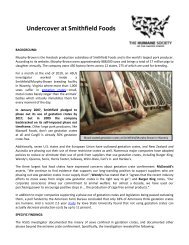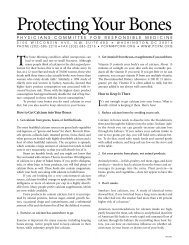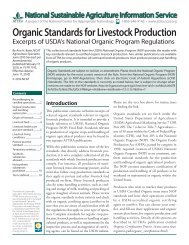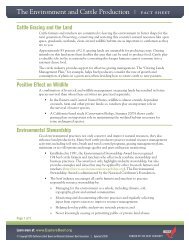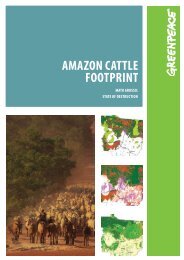THE MYTHS OF VEGETARIANISM Stephen Byrnes, PhD
THE MYTHS OF VEGETARIANISM Stephen Byrnes, PhD
THE MYTHS OF VEGETARIANISM Stephen Byrnes, PhD
You also want an ePaper? Increase the reach of your titles
YUMPU automatically turns print PDFs into web optimized ePapers that Google loves.
not so long ago, soy was an Asian food primarily used as a condiment, now a variety ofprocessed soy products proliferate in the North American market. While the traditionallyfermented soy foods of miso, tamari, tempeh and natto are definitely healthful in measuredamounts, the hyper-processed soy "foods" that most vegetarians consume are not.Non-fermented soybeans and foods made with them are high in phytic acid (110), an antinutrientthat binds to minerals in the digestive tract and carries them out of the body.Vegetarians are known for their tendencies to mineral deficiencies, especially of zinc (111) and itis the high phytate content of grain and legume based diets that is to blame (112). Thoughseveral traditional food preparation techniques such as soaking, sprouting, and fermenting cansignificantly reduce the phytate content of grains and legumes (113), such methods are notcommonly known about or used by modern peoples, including vegetarians. This places them(and others who eat a diet rich in whole grains) at a greater risk for mineral deficiencies.Processed soy foods are also rich in trypsin inhibitors, which hinder protein digestion. Texturedvegetable protein (TVP), soy "milk" and soy protein powders, popular vegetarian meat and milksubstitutes, are entirely fragmented foods made by treating soybeans with high heat and variousalkaline washes to extract the beans' fat content or to neutralize their potent enzyme inhibitors(114). These practices completely denature the beans' protein content, rendering it very hard todigest. MSG, a neurotoxin, is routinely added to TVP to make it taste like the various foods itimitates (115).On a purely nutritional level, soybeans, like all legumes, are deficient in cysteine and methionine,vital sulphur-containing amino acids, as well as tryptophan, another essential amino acid.Furthermore, soybeans contain no vitamins A or D, required by the body to assimilate and utilizethe beans' proteins (116). It is probably for this reason that Asian cultures that do consumesoybeans usually combine them with fish or fish broths (abundant in fat-soluble vitamins) orother fatty foods.Parents who feed their children soy-based formula should be aware of its extremely highphytoestrogen content. Some scientists have estimated a child being fed soy formula is ingestingthe hormonal equivalent of five birth control pills a day (117). Such a high intake could havedisastrous results. Soy formula also contains no cholesterol, vital for brain and nervous systemdevelopment.Though research is still ongoing, some recent studies have indicated that soy's phytoestrogenscould be causative factors in some forms of breast cancer (118), penile birth defects (119), andinfantile leukemia (120). Regardless, soy's phytoestrogens, or isoflavones, have been definitelyshown to depress thyroid function (121) and to cause infertility in every animal species studiedso far (122). Clearly, modern soy products and isolated isoflavone supplements are not healthyfoods for vegetarians, vegans, or anyone else, yet these are the very ones that are mostconsumed.MYTH #11: The human body is not designed for meat consumption.Some vegetarian groups claim that since humans possess grinding teeth like herbivorous animalsand longer intestines than carnivorous animals, this proves the human body is better suited forvegetarianism (123). This argument fails to note several human physiological features whichclearly indicate a design for animal product consumption.First and foremost is our stomach's production of hydrochloric acid, something not found inherbivores. HCL activates protein-splitting enzymes. Further, the human pancreas manufactures





